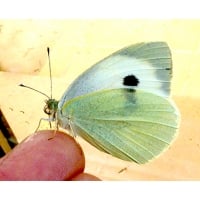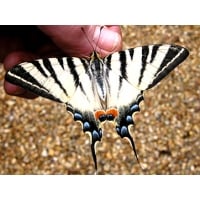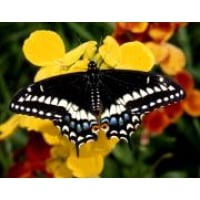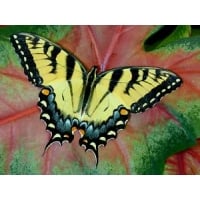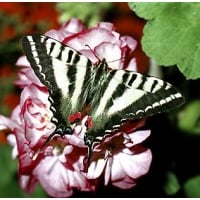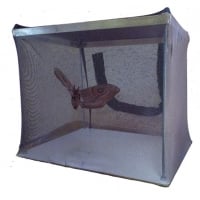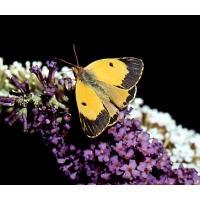CURRENT PUPAE - Chrysalides and cocoons
If you are a beginner and need information on rearing from small caterpillars, or hatching out pupae, please order the All Colour Paperback BUTTERFLIES. INSTRUCTIONS ARE NOT SENT WITH EACH SPECIES, you need to acquire basic skills and this book is a simple way of doing so.
Please Select a Category Below:
PUPAE NEST
The Pupae Nest, using sheets of bobble foam, is the innovative method used by WWB to keep subterranean pupae, in particular, and other pupae and cocoons in ideal conditions in the emerging cage.
• Developed specifically for underground pupae: also ideal for cocoons and unattached pupae.
• Immediate access to pupae for inspection, without disturbance.
• Provides healthy and moist conditions.
• Easy observation of pupae that are forming up prior to emergence.
• Allows the breeder to anticipate the emergence of required males or females.
• Ensures hygiene and avoidance of harmful bacteria.
This method has proved to be better than using soil or compost, because it enables instant inspection whenever required, for removal of empty pupal shells or any dead pupae, and to be able clean up, with minimum disturbance of the pupae. The pupae rest in the depressions, in natural conditions of humidity and hygiene. If they were on plain foam sheets they would roll around, and would be less able to benefit from the humidity assisted by the depressions, which also provide separation. The covering sheet of foam is placed with the bobble side down, so both of the indented sides are together, which allows some airflow and eases the passage for adults to emerge and climb to dry their wings.
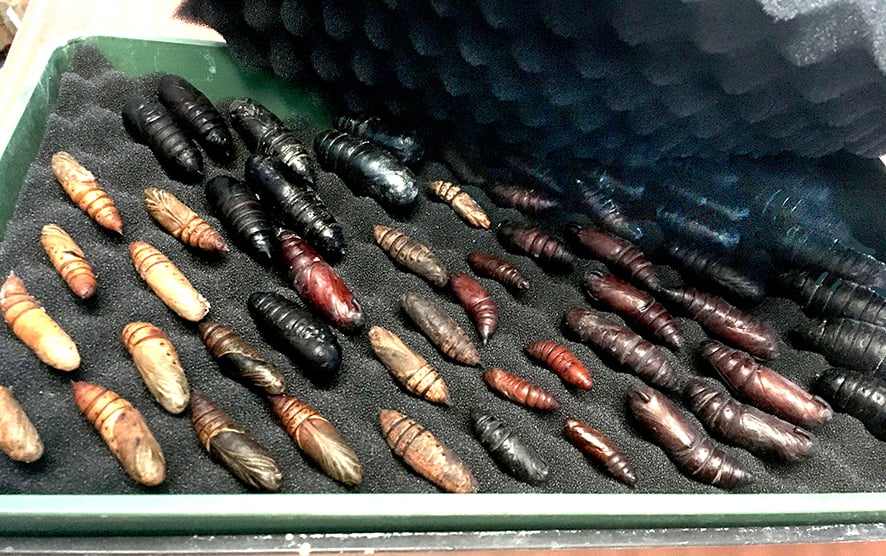
The pupae and foam should be sprayed thoroughly (not just misted) every day, or more often in higher temperatures. If already moist when you next come to spray, you can reduce or omit further spraying. The pupae and foam should be sprayed thoroughly (not just misted) every day, or more often in higher temperatures. If already very moist when you next come to spray, you can reduce or omit that day's spraying. The base of the upper tray is perforated to allow drainage. It rests in an unperforated tray with a block to separate the two trays and receive the drained water. This drainage allows liberal watering, without risk of the pupae lying in water.
Cocoons also do well resting on a bobble foam sheet, usually without another sheet covering them, though in exceptionally hot conditions, a moist foam sheet on top of the cocoons, helps to maintain humidity. Cocoons require very liberal watering, not a just a fine mist. Soak them thoroughly, safe in the knowledge that they are well drained.
Butterfly pupae, which in the wild are not formed underground, are usually fixed to a twig or other surface, either hanging from the tail cremaster, or (dependent on their family) upright and held in place by a silken girdle. You can go to the trouble of emulating this artificially (the way to suspend pupae is described in the Exotic Butterfly Pupae section) or they can be laid on the surface of the foam and not covered. As long as they are misted to avoid them drying out, the butterfly usually forms successfully in such pupae laid on foam, and the porous surface helps give the emerging butterfly the grip needed to pull itself out of the chrysalis shell, and crawl to the netting wall of the cage to expand and dry its wings.
From time to time, it is good practice to remove the pupae, wash the foam thoroughly, spray with dilute bleach (about 10% solution, which is not harmful to the pupae) then replace the pupae on nice wet foam. In summer the foam is normally washed about every 2- 3 weeks, using hot water with a touch of bleach added, but without soap or detergent which would create problems with froth and would take too long to rinse away. The washing interval depends on the extent of hatching activity and temperature. Any hint of smell, or slippery feel to the pupae, indicates bacteria, and means that washing is overdue. When adults emerge from the pupa, a waste product Meconium, is ejected. This is only harmful if left so long that it spoils the freshness and encourages bacteria. Empty pupal shells and any other organic matter, are best frequently removed, to avoid build-up of mould or bacteria. In the emerging cage, pupae that are crowded together can develop a slime, caused by bacteria, which slows development and can kill pupae. Pupae nests help to eliminate such risk and periodic washing gives maximum hygiene.
When washing the foam sheets, it is also important to wash and disinfect the two trays. If you are incubating quite a lot of pupae it makes it more convenient to have two Pupae Nests, so you can move the pupae straight into a prepared clean Nest. To encourage this, there is a price reduction for two nests bought together.
TO INCUBATE pupae and COCOONS An emerging cage should have netting sides with plenty of ventilation. This provides grip for emerging adults, and you can add some sticks. In summer conditions, you can incubate temperate pupae at room temperature, without further heating, but when it is cool you may wish to add warmth. When you heat, the ambient temperature can be raised to 25º over a few days, and increase further to 30º if required. The air around the cage needs to be heated: they don’t do so well if heat is directed at the pupae or the cage. Don't stand the cage on a heat source. You cannot over-water the cocoons as long as they are able to drain. You can hang cocoons: if you do they then need more frequent and heavy watering.
The Pupae Nest is based on standard seed tray size 24 x 38 cms which fits the Standard Pyjama Cage.

Exotic butterfly pupae should be incubated, totally shaded, in a tropical greenhouse. The ambience of a tropical greenhouse is not easy to emulate. Some breeders are successful in re-creating such conditions, but it us not sufficient simply to achieve a high temperature and humidity. For details of how to attach tropical butterfly pupae to twigs, or bamboo, please see the introduction to the Exotic Butterfly section of the WWB website. Exotic butterfly pupae that are not suspended but lying loose, can be laid on the bobble foam of a Pupae Nest, and left uncovered. Remember incubating pupae must always be in full shade.
Large White Butterfly Pieris brassicae
No longer the common butterfly it once was. Summer pupae may hibernate, especially if chilled, and some will emerge to give a further generation.
Winter pupae are stored cool and normally hatch in May, though some occasionally develop during winter.
This is a good species for the inexperienced, and as an introduction to rearing larvae.
The larvae feed on cabbage but also most Cruciferae which can be better and less smelly for captive rearing! Horseradish is ideal for its large leaves and other species include Rape, Mustard, Sweet Rocket, Turnip and Watercress.
There are two or more generations in a year.
European Swallowtail Papilio machaon gorganus
Very difficult to obtain, there are seldom enough to meet demand. Keep winter pupae refrigerated until late April. Lay the pupae on foam sheet in the base of a netting emerging cage. Spray in hot weather. The butterflies normally emerge in May/June.
For breeding, the butterflies require some space, nectar flowers and growing foodplant. They need sunlight and humidity. Give them a shady area in the cage. Eggs are laid on the foodplant leaves.
The larvae are very easy to rear on Fennel, Carrot leaves and Parsnip leaves and flowers (wild and cultivated). One of the most attractive butterfly larvae and a joy to rear!
Scarce Swallowtail Iphiclides podalirius
Good size, plump and clear colour. Increasingly difficult to obtain. The larvae feed on Blackthorn. Most people find this species difficult to breed but it is a joy to have them emerge at home, and worth trying to breed.
Black Swallowtail Papilio polyxenes asterias North America
Very closely related to the European and British swallowtails, asterias will often hybridise with either, producing interesting offspring.
The collections of 4 pupae comprise 3 male and a female pupa for breeding.
The larvae feed on Fennel, Carrot tops, and some other Umbelliferae including wild and probably cultivated Parsnip. Two broods are produced in the year and the pupae of the second brood hibernate.
Tiger Swallowtail Papilio glaucus North America
The Tiger Swallowtail is perhaps North America’s grandest swallowtail. As a curiosity, a small proportion of females emerge as melanics, not as beautiful as the typical female, but different! They can be bred in captivity and the larvae are as exotic as many of the tropical swallowtails, with the Papilio eye markings and bird dropping camouflage in the early instars.
Try feeding them on Cherry, Ash or Lime, and they will probably take a wider variety of foodplants.
Swordtail Euritides marcellus North America
Very difficult to obtain now. Dormant pupae to breed in the spring.
Larvae of this magnificent swordtail feed on PawPaw Asminia species and will also accept Soursop Anona species. The larvae are very variable in the density of markings and background colour, ranging from green with no striping to nearly black with dense ringed markings.
The pupa is almost indistinguishable from the European Scarce Swallowtail podalirius.
The adults fly well in a conservatory and breed easily when the foodplant is present.

All Colour Paperback BUTTERFLIES Robert Goodden.
No other book gives such plain and practical advice for the study of butterflies and moths.
A comprehensive guide - outlining techniques for the breeding and study of butterflies and moths. This book also shows a grand selection of butterflies of every continent. Packed with essential information, colourful pictures and diagrams by the butterfly artist JOYCE BEE. Paperback. 160 pages. 7 x 4". An essential guide for the beginner.
This book went out of print many years ago. WWB bought the entire stock of the English language edition. Stocks have now sold out. There are some used copies, damage or marking mainly on the covers, which does not materially affect the content. Even these are now down to rather few copies.
Published by Hamlyn. Available only from Worldwide Butterflies.
Pyjama Mini Cage 22 x 29 x 25cm high
This popular cage has just got even better. Nearly a third larger, and much improved dimensions.
Ideal as a beginner's cage, but also for the busy breeder who wants separate small cages. Excellent as an emerging cage for chrysalides and cocoons, ideal for keeping small numbers of larvae or other insects, when large enough for cage rearing.
This cage is suitable for laying out small numbers of pupae to emerge. Also for rearing smaller numbers of larvae or smaller larvae. Baby larvae should be first reared in plastic rearing containers or kept covered on growing food. Please see the note on the page for plastic rearing containers. This cage will hold small covered pots of plant, and larger sizes of cage are available for larger subjects.
When necessary the netting cover can be slipped off for cleaning or replacement. The Pyjama Mini cage is assembled in minutes and easily packed flat for winter storage. As the interest grows there are larger sizes available. For the experienced breeder the Mini Cage has many uses where a series of smaller cages is needed for separating species and giving different treatment.
The cover can be washed by hand or machine, making your used cage like new for almost no effort, and no cost.
The Giant Swallowtail Papilio cresphontes North America
This is North America's largest butterfly. An impressive broad-winged Swallowtail as fine as any tropical species. The Giant Swallowtail will breed in captivity. The larvae, which are knarled and resemble a bird dropping, feed on Rutaceae: Citrus, Rue and probably Choisya, as well as Zanthotoxylum.
New Clouded Yellow Colias australis
Because of travel prohibition our normal breeders will not have stock this year. We are therefore hoping to source pupae from Europe. If it proves impossible, orders will be booked for supply in the summer of 2021.
Almost indistinguishable from the Pale Clouded Yellow hyale. This species was not recognised until 1947 when a Belgian entomologist, M. Berger, found that the larvae not only fed on Horseshoe Vetch Hippocrepis, but are totally different in appearance, having a brilliantly coloured pattern in black, yellow and green. Larvae will produce butterflies again this season. They will also feed on Crown Vetch Coronilla.
Clouded Yellow Butterfly Colias crocea
These pupae produce butterflies in a week or two at 18-20 degrees.
A great favourite with entomologists and extremely easy to rear on potted Clover. The larvae grow fast and will produce butterflies very quickly, particularly in warm conditions.


